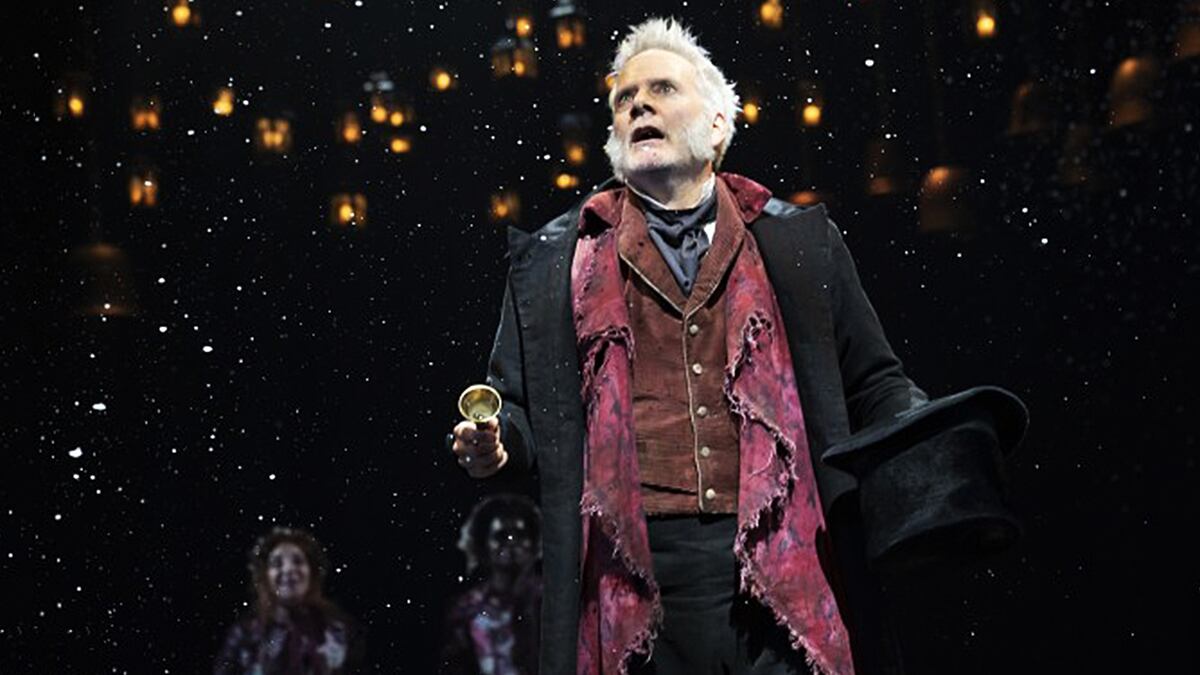From the moment you enter Broadway’s Lyceum Theatre, prepare for joy. Very Christmassy joy, even if it is a little early.
In the aisles and from the stage, Campbell Scott (Scrooge), Andrea Martin (the Ghost of Christmas Past), LaChanze (the Ghost of Christmas Present/Miss Fezziwig) and their castmates of A Christmas Carol (booking to Jan. 5) throw cookies and clementines from the stage to as many people as they can in every corner of the theater.
This is lovely, and sets the tone of a show, adapted by Tony Award-winner Jack Thorne and produced by London’s Old Vic, that invites you (and any children you wish to take with you) into its story in the best way; go see it, and enjoy every fabulous, visually sumptuous second. You will cry a lot, smile a lot, and leave the Lyceum full of the best festive spirit. (How long the streets of New York City will facilitate you maintaining that warm and fuzzy feeling is another matter, of course.)
ADVERTISEMENT
Rob Howell’s set and costume design are Dickens-perfect, with cloaks and bustles crisp and correct and lanterns hanging from every orifice of stage and surrounds. Scrooge’s home and office is effectively conveyed with the four metal rectangles that rise and fall from the stage; both a physical and psychological prison. At the beginning, and throughout the play, carols are sung beautifully by the company (sometimes with tinkly, note-perfect hand bells).
But this production is not light in any way. Thorne’s script digs deep into Scrooge’s miserliness and cruelty towards figures like Bob Cratchit (Dashiell Eaves). It’s at first the mindless cruelty of a despot, and it will not surprise you that Scott’s Scrooge—with nothing said—seems very much like the current president; a bully for his own effect, a bully just because he can; someone who exerts power and creates sadness and negative chaos without a care because he is the only person who matters. You work for him, you exist around him, the world orbits him.
Matthew Warchus’ brisk direction keeps the story moving, with brilliant dramatic lighting flourishes by Hugh Vanstone. But Warchus also mines the text for meaning and depth—as soon as the ghosts start appearing, so will your tears.
The wonderful, Tony-winning performers Martin and LaChanze are not providing Scrooge playful or mischievous glimpses of his and other lives to show him the error of his ways. They are quizzical, sometimes scornful, guides to his failings—including the sight of Tiny Tim (Sebastian Ortiz) in dire need of help, as well as good-hearted and loyal nephew Fred (Brandon Gill), and lost love Belle (a bracingly measured Sarah Hunt).
Ortiz has cerebral palsy, just as Jai Ram Srinivasan—who he shares the role with—has; their shared disability adds an important layer of reality to the Cratchit family’s challenges, and it is lovely seeing Ortiz not only perform his part so well but the company coalesce around him during the closing scenes. Key moments are played, extremely sensitively, at his pace.
You note that all the people done bad by Scrooge try and find excuses for him, reasons for the way he is; humans searching for humanity even where none has been exhibited. This, we remind ourselves, is what we do when faced with such terrible behavior. We ask why. And so does A Christmas Carol, and the cast, and particularly the excellent Scott, press every emotional button—not mawkishly—as (this very handsome) Scrooge investigates his past: the abusive father, the initial joy of independence, the desire to make money in his father’s image, and the construction of those simple and deadly walls.
And then to the future: Scrooge’s coffin faces him, as those who loved him try valiantly to think of something nice to say about him. But mostly, what they feel and what Scrooge sees is what a waste of a life and a human being. Your eyes won’t fill with tears once, and then be done. Take tissues, there will be a lot of dabbing.
And that also means tears of joy. If you recall those cookies and clementines at the beginning, you ain’t seen nothing yet when it comes to audience participation, because when Scrooge finally and giddily throws off the shackles and decides he needs to give the Cratchit family a Christmas to remember, we are all involved in what becomes a spectacular, theater-filling yuletide conveyor belt. And yes, there will be snow and it falls very prettily too.
A Christmas Carol isn’t done, even after Scrooge is filled with warmth and self-knowledge and when his atonement has been achieved. As LaChanze’s Ghost of Christmas Present makes clear, a redemption is only stage one and doing right is an ongoing commitment. This is a process and change of character that must be paid attention to and maintained.
The Ghost of Christmas Present is rightly circumspect about Scrooge’s change of heart, and this is A Christmas Carol’s hard coating to all the feelgood merriment: our duty and responsibility to behave well and honorably is on us every moment of every day.
This is Scrooge’s first day of good, and it is indeed wonderful to see. But for him, the ongoing challenge will be to stay good. And that, A Christmas Carol makes gently and firmly clear, is our challenge too.
To that end, prepare to liberate any spare dollars you have. The musical is also raising money for Broadway Cares/Equity Fights AIDS and Hearts of Gold, a charity that helps homeless mothers and their children “to become confident and self-sufficient as they prepare to transition out of the New York City shelter system to permanent homes.”






